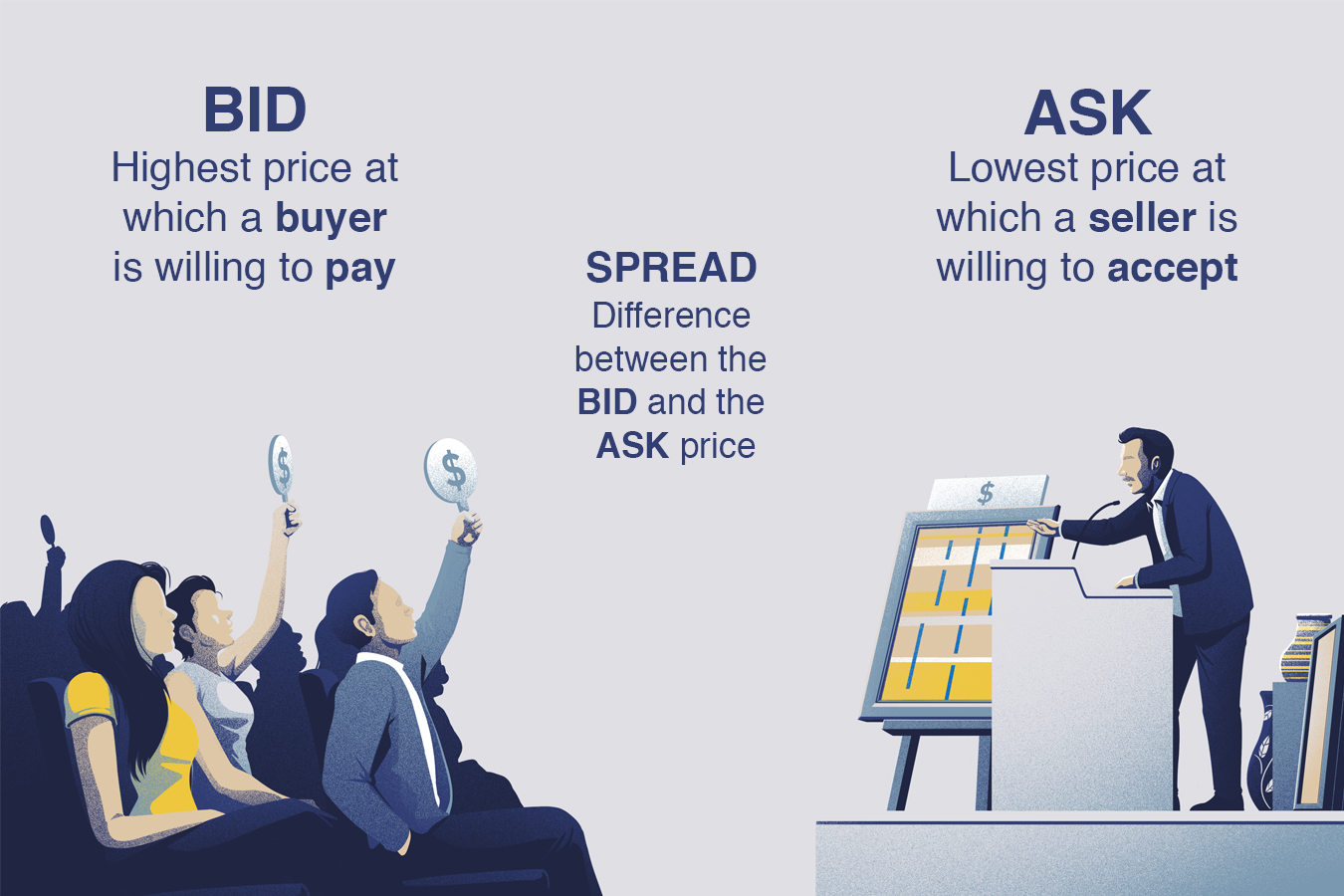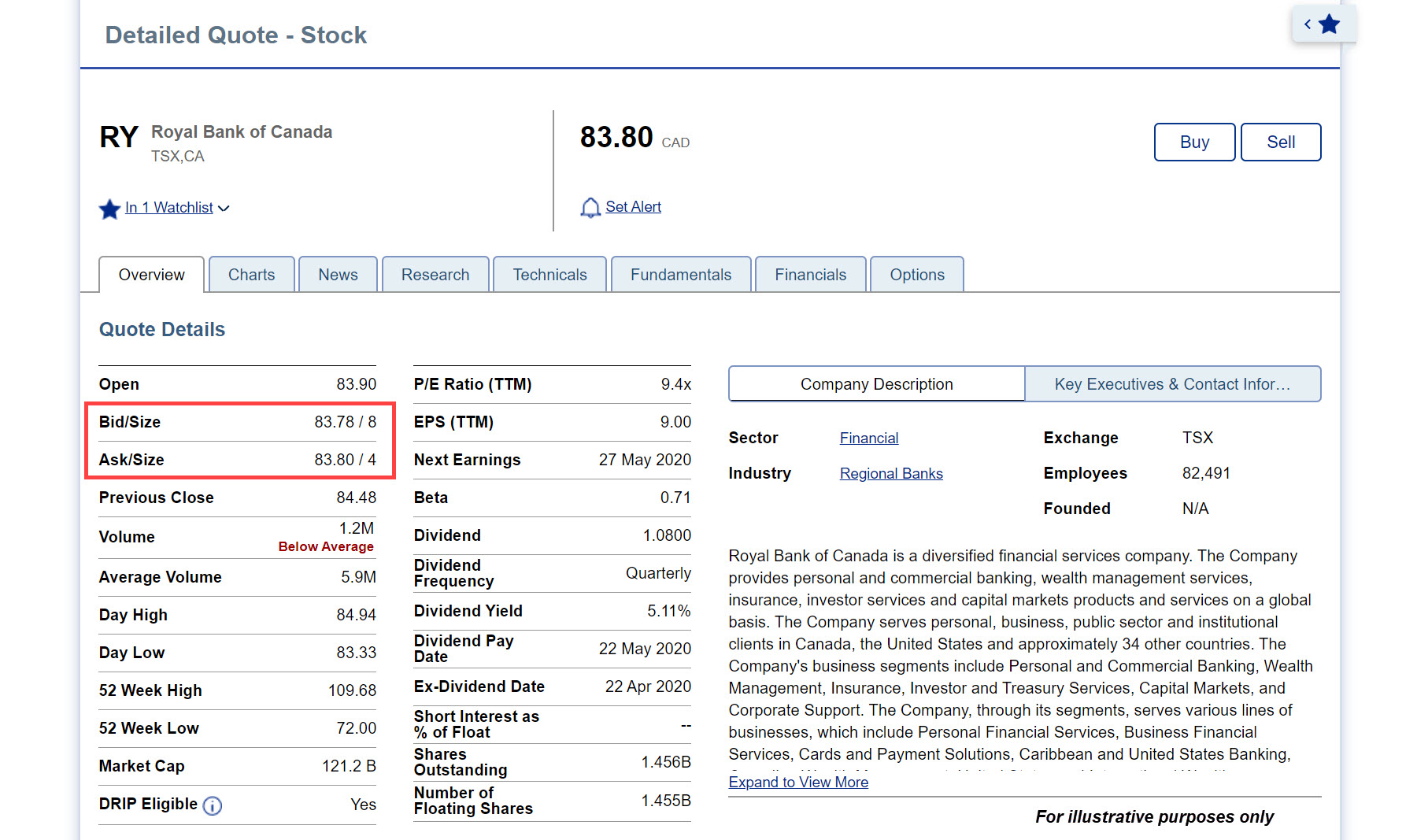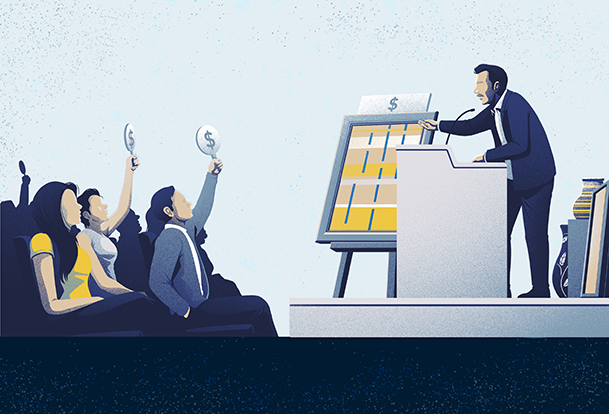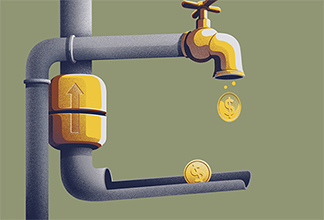Trading Stocks: What You Need to Know to Get Started
Published on May 6, 2019
minute read
Share:
Once you've done your research, you may have decided on an investment that's right for you. Before you start trading, it helps to have some knowledge of how buying and selling securities like stocks and exchange-traded funds (ETFs) works.
We'll walk you through some of the key things to know about placing trades — including the bid and ask section of a stock quote — and describe three of the most common types of orders.
Bid and Ask
Like any marketplace, there are two sides to every trade: a buyer and a seller. A buyer submits a bid, which is the highest price they're willing to pay for a security, while a seller submits an ask, which is the lowest price they're willing to accept.

Buyers and sellers each also submit the number of shares they are willing to purchase or sell. There is often a long list of buyers and sellers waiting to have their orders filled at different prices.
Spread
The difference between the bid and the ask is called the spread. Sometimes the spread can be quite wide. At other times, the difference may be no more than a penny. In general, more liquid securities — those that trade more often in higher volumes — will have a narrower spread.
Size
The number of shares available at the bid and ask price is referred to as size, and can be found alongside the bid and ask in a detailed quote.
Here where you'll find each:

Size is counted in board lots. A board lot is a standard number of shares that's determined based on two things: the exchange where the security trades and the stock price. Generally, a board lot for stocks priced at $1 or more is equal to 100 shares. If you trade a number of shares that's not a full board lot, it is referred to as an odd lot.
| Board Lot Size | TSX & TSX Venture |
| 100 | stocks priced at $1.00 and over |
| 500 | stocks priced at $0.10 to $0.99 |
| 1,000 | stocks priced under $0.10 |
Stocks trading on the NYSE and NASDAQ priced at $1.00 or higher generally have board lots of 100 shares. Large-dollar-value stocks may trade in smaller board lots.
Watch Video: How to read a stock quote
Order Types
Here are the most popular types of trades and how they work.
1. Market order
When you place a market order to buy or sell a security, you don't specify a price and your order will typically be executed immediately at the best available price.
Here's an example:
You're buying 1,000 shares of a security. The best ask price is $5 for 300 shares. The next best ask price is $5.50 for 2,000 shares. Your market order would first snap up the 300 shares at $5. The remaining 700 shares would be filled at $5.50. Your average cost would be $5.35, plus any applicable commission/fees.
PRO: With a market order, it's likely that your order will be filled quickly during trading hours.
CON: When placing market orders, prices may vary widely, especially on thinly traded stocks. You could be surprised by the price you end up with, even with a heavily traded security. Sometimes price movements are fast and volatile.
If you're buying or selling a heavily traded stock with a narrow spread, the difference in price is usually minimal. However, thinly traded securities with wide bid/ask spreads could result in you paying or receiving a price that's significantly different than what you expected based on the last trade price.
REMEMBER: If you place an order when the market is closed, your order is likely to be filled when trading resumes on the next business day. A lot can happen overnight, and a stock may start trading at a much higher or lower price from where it closed the previous day.
2. Limit order
When you place a limit order to buy or sell a security, you state the maximum price you are willing to pay when buying (or minimum sale price when selling), along with the number of shares. Your order will be entered in the system and will stay open until it is filled, cancelled or expired.
Here's an example:
A stock is trading at $21. You enter a limit order to buy it at $20. If the price continues to rise, your order may never be filled and you might miss a buying opportunity. However, if the ask price drops to $20, your order would be partially or completely filled, depending on how many shares are available at that price. Your order could also be filled at a better price since your limit order is the maximum price you want to buy the stock for, but if the stock falls below that, you could end up with a lower price.
PROS: You have control over the fill price. You can set a "good through" period, which leaves your order open for a specified time period to wait for the price to meet your limit price. On U.S. exchanges, you can also specify "any part" or "all or none," which lets the system know you're willing to accept a partial fill if there aren't enough shares available to complete your order. Only "any part" orders are available on Canadian exchanges.
CON: There is no guarantee that your order will be filled.
REMEMBER: If there's a buyer or seller willing to meet your price, your order will likely be filled at the price you specified, or better. However, limit orders are first-come, first-served. If other investors placed orders with the same limit price before you, you're out of luck.
When deciding whether to place a market order or limit order, you need to decide what's more important: ensuring a speedy transaction or having control over the price.

3. Stop order
Stop and stop-limit orders can be used to buy or sell stocks when they hit a price predetermined by you. Orders are triggered only if the price of the security hits your chosen price before the order expires. The order that's triggered can be either a market or limit order.
Here's an example:
You own 100 shares of Company XYZ. It is trading for $50, but you think the price is going to fall and want to sell if it does. You could place a stop-limit order with a stop price of $45 and a limit price of $44.
That means that if the price drops to your stop price of $45, the order to sell will be triggered. In this case, your order becomes a limit order to sell 100 shares at $44 or better.
PROS: You can set your limit price to equal your stop price. Stop orders can be used if you are unable to monitor your portfolio for a period of time, such as when you're on vacation.
CON: If the number of available shares is limited or the market is moving quickly, your order might not be filled.
REMEMBER: When setting your stop price, keep in mind that if you set it very close to the current price, it could be triggered by normal market volatility rather than any company-specific movement in the price.
For Canadian markets, only stop-limit orders are accepted, not stop orders. U.S. markets accept either stop or stop-limit orders. Stop orders without a limit become market orders when triggered.
You can also place a stop order to buy a stock. For example, you think the price of a stock is going up, you could place a stop-limit order to buy — setting the stop price above the current price. If the price goes up to the price you specify, a limit order to buy will be triggered.
RBC Direct Investing Inc. and Royal Bank of Canada are separate corporate entities which are affiliated. RBC Direct Investing Inc. is a wholly owned subsidiary of Royal Bank of Canada and is a Member of the Investment Industry Regulatory Organization of Canada and the Canadian Investor Protection Fund. Royal Bank of Canada and certain of its issuers are related to RBC Direct Investing Inc. RBC Direct Investing Inc. does not provide investment advice or recommendations regarding the purchase or sale of any securities. Investors are responsible for their own investment decisions. RBC Direct Investing is a business name used by RBC Direct Investing Inc. ® / ™ Trademark(s) of Royal Bank of Canada. RBC and Royal Bank are registered trademarks of Royal Bank of Canada. Used under licence.
© Royal Bank of Canada 2022.
Any information, opinions or views provided in this document, including hyperlinks to the RBC Direct Investing Inc. website or the websites of its affiliates or third parties, are for your general information only, and are not intended to provide legal, investment, financial, accounting, tax or other professional advice. While information presented is believed to be factual and current, its accuracy is not guaranteed and it should not be regarded as a complete analysis of the subjects discussed. All expressions of opinion reflect the judgment of the author(s) as of the date of publication and are subject to change. No endorsement of any third parties or their advice, opinions, information, products or services is expressly given or implied by RBC Direct Investing Inc. or its affiliates. You should consult with your advisor before taking any action based upon the information contained in this document.
Furthermore, the products, services and securities referred to in this publication are only available in Canada and other jurisdictions where they may be legally offered for sale. If you are not currently a resident of Canada, you should not access the information available on the RBC Direct Investing Inc. website.
Inspired Investor brings you personal stories, timely information and expert insights to empower your investment decisions. Visit About Us to find out more.










